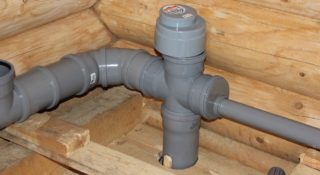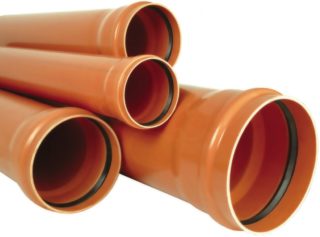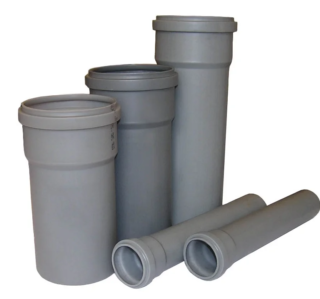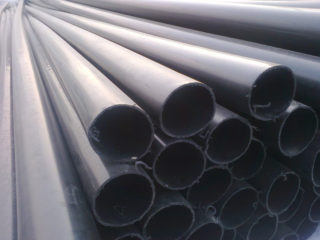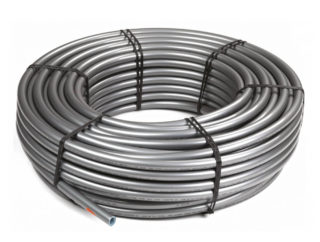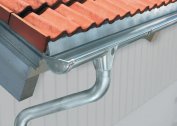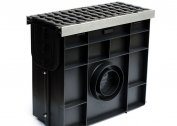The volume of production of plastic pipes is growing every year. This is due to their low cost and ease of use. Different types of plastic are suitable for both internal sewage and external wiring. It remains to be determined which types of plastic are more profitable to use for internal work, which for external work, and also what affects the life of synthetic materials.
Scope of plastic sewer pipes
At the end of the last century, the main materials for arranging water supply and sewage systems were metal and cast iron. They had their advantages, but there were many shortcomings. For example, the metal was corroded due to exposure to chemicals that somehow enter the sewers. If drinking water contained iron ions, the process proceeded faster. Cast iron constructions are more practical in terms of rust formation, but the material is very heavy and in addition has an uneven inner surface, which quickly led to dirt sticking and the need to clean the blockages.
New technologies and materials are quite capable of replacing metal. Plastic is several times lighter, but in terms of strength and durability it is not inferior to metal fittings. The pace of production and the emergence of new types of plastic indicate that now few of the builders use steel or cast iron to equip private sewers.
Plastic products are the common name for all synthetic pipes. They are distinguished by material and manufacturing technology:
- polypropylene;
- PVC
- polyethylene;
- crosslinked polyethylene;
- metal plastic.
Depending on the characteristics of the material, it is used in various fields - for the supply of drinking water, the disposal of domestic waste water, and the pumping of aggressive liquids.
For convenience, pipes are made in color - orange, blue, gray. This allows you to choose them correctly: orange is used for external sewage, and gray for internal.
In addition to color, an important indicator is the pressure that the pipe can withstand daily. If the pressure of the water often changes in an apartment building, it is not recommended to make sewers with glue. It is necessary to use pipes with a bell at the ends.
In addition to the water supply and sewerage pipes of smaller diameter are used in the floor heating system, for internal wiring of coolants in a house or apartment.
Production Material and Specifications
Before buying plastic pipes for arranging a sewer or water supply system, it is necessary to pay attention to the technical characteristics of the material and measure the pros and cons.
Polypropylene pipes
Polypropylene is produced in the form of granules, from which pipes of different diameters are cast during heat treatment. PP does not chemically interact with acids and alkalis, does not emit harmful substances, therefore it can be used in the cold and hot water supply system. The material becomes soft at 145 degrees, so it can withstand hot runoffs up to 95 degrees without deformation.
Physico-mechanical properties:
- resistant to mechanical shock;
- low temperatures have no effect if ethylene is added to the molecules;
- resistant to wear;
- aluminum-reinforced polypropylene is less deformed when heated;
- sensitive to oxygen and ultraviolet - to reduce performance, stabilizers are added to the composition.
Depending on the filling, you can create a material with new properties:
- Glass-filled.Fiberglass increases bending elasticity and increases the strength of finished products.
- Mineral filled. The introduction of calcium carbonate increases the thermal insulation properties of PP.
- Elasticized. When adding elastomers, the frost resistance of the pipes and their elasticity during bending are increased.
- Hardly combustible. Produced by mixing granules with antiprene. In case of fire, the material dies out on its own.
Polypropylene plastic pipes are much cheaper and more practical than metal ones. They have a smooth inner surface, which eliminates the buildup of dirt and clogging of the sewer. Mineral deposits - calcium, iron - are not able to clog the lumen and change the diameter of the pipes, because the material does not electrify and does not attract salt molecules. It is recommended to install filters for drinking water if it contains dissolved minerals, as they can damage household appliances - dishwashers and washing machines, a boiler, boiler or heating radiators.
Polypropylene is the second material after PVC in the ranking of production volumes.
PVC sewer pipes
Unplasticized polyvinyl chloride is a material that successfully replaces steel structures, which are much more complicated and expensive to maintain. It is used in the food and chemical industries, since PVC can withstand the aggressive load of acids - nitric, hydrochloric, sulfuric, and does not emit harmful substances into the transported liquid.
Characteristics:
- low expansion coefficient when heated;
- the material begins to soften at 80 degrees;
- melts at 180 degrees;
- in warm time it is steady against blows.
The disadvantage of PVC is that brittleness increases with decreasing temperature.
PVC pipes are smooth inside, which eliminates sewage blockages with the correct angle of inclination. Mineral deposits do not stick to the material, therefore, the diameter remains the same throughout the entire service life.
Polyethylene pipes
For the manufacture of pipes using high density polyethylene. The service life of the material is about 50 years. This is much longer than pipes made of concrete, metal or cast iron.
Advantages of polyethylene pipes for sewage:
- Do not deteriorate in contact with water or aggressive liquids;
- environmentally friendly;
- no additional consumables are required for welding, as for steel;
- the laying process takes less time due to the relatively light weight of the products;
- elastic - withstand pressure and temperature, while not cracking and not being deformed;
- ice that forms inside the pipe does not damage it;
- Suitable for laying in areas where there is a high load on the ground, and earthquakes often occur.
Used plastic pipes can be recycled and reused.
Crosslinked Polyethylene
Not inferior in strength to solids. Get it by adding peroxides, silane, nitrogen.
The advantages of cross-linked polyethylene over ordinary:
- thermal insulation properties are 30% higher;
- resistant to ultraviolet radiation and atmospheric phenomena, therefore, it can be used to equip an open water supply system;
- high mechanical tensile strength, as well as the flexibility of the material;
- in frosts below 50 degrees shockproof.
The material burns at a temperature of 400 degrees, while decomposing into water and carbon dioxide. Melts at 200 degrees. It is used in seismically hazardous areas because pipe connections are not disturbed by soil shifts.
Types of pipes and connections
Depending on the load on the soil, the climatic conditions of the region, the type of water or sewer system, as well as the amount of wastewater, the pipes are selected by material and diameter.
In the northern regions, more frost-resistant materials must be preferred.In places where there is a risk of soil displacement, choose pipes that are firmly connected to each other end-to-end using heat sealing.
For home sewers, various types of fittings are provided for plastic pipes in order to simplify the transitions from a wider diameter to a smaller one and vice versa. Before buying, you need to check the plan for laying the sewer and find the right fittings.
In a straight pipe connect end-to-end or with sockets. The second option is more reliable. Connection by coupling or flange is possible.
Dimensions and Diameters
 The diameter of the plastic sewer pipes for a private house or apartment is chosen 110 or 50 mm. For household appliances, a shower, a bathtub and a sink 50 mm is suitable. For the toilet - 110 mm. For the laying of industrial sewage pipes of large diameter are used: 200 - 300 mm.
The diameter of the plastic sewer pipes for a private house or apartment is chosen 110 or 50 mm. For household appliances, a shower, a bathtub and a sink 50 mm is suitable. For the toilet - 110 mm. For the laying of industrial sewage pipes of large diameter are used: 200 - 300 mm.
Regardless of the type of pipe, their dimensions remain standard so that products from different materials can be used in one system.
Pressure pipes differ from pressureless walls in wall thickness. In a non-pressure system, where fluid flows due to slope, the thickness can be about 3-5 mm. If a pump is used for pumping, which creates pressure, the wall thickness must be selected based on the expected pressure.
Size table of PVC sewer pipes for a private house.
| External diameter | Wall thickness | Where is used |
| 50 mm | 1.3 mm | Shower, bathtub, bidet, washing machine |
| 90 mm | 2.2 mm | Dishwasher |
| 110 mm | 2.7 mm | Toilet bowl |
| 200 mm | 4.9 mm | External sewage, if there is a sauna |
| 315 mm | 7.7 mm | Pool |
Dimensions are for pressureless sewage systems.
Mounting Features
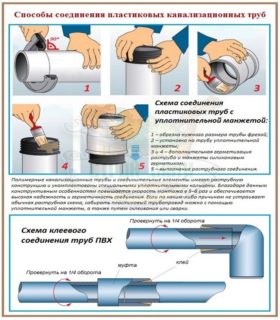 To avoid blockages along the wastewater route, pipe laying starts from the main riser in the direction of the well. Pipes should initially be taken larger than the calculated diameter - this is for safety reasons - in case of installing new plumbing or building a bath with a pool.
To avoid blockages along the wastewater route, pipe laying starts from the main riser in the direction of the well. Pipes should initially be taken larger than the calculated diameter - this is for safety reasons - in case of installing new plumbing or building a bath with a pool.
There are two connection options:
- Detachable when couplings or flanges are used. Tightness is ensured by rubber gaskets. The method is convenient in that if necessary, the water supply or sewerage can be disassembled by simply removing the couplings.
- One-piece - in a bell, by means of welding or glue. Glue is selected depending on the materials. For polymers, this is epoxy.
Not all methods are available to beginners, so it is better to contact professional workers, or choose the easiest way to connect.
Advantages and disadvantages
The easiest way to connect the pipes to the bell. It is important to attach a rubber ring for tightness, and the bell itself should be directed to the side where the water flows. This reduces the risk of blockages. To make the pipes easily docked, use a lubricant or ordinary detergent.
Welding is a complicated method. Without the skills to make a pipe connection, it will not be easy. For pressureless sewage, welds are quite reliable.
The use of epoxy glue allows you to connect the parts of the pipes at the molecular level. Before starting work, the joints are degreased. You need to act quickly, since the resin dries quickly in air.
Fittings are installed on o-rings to prevent leakage at joints.
Operation and maintenance
If the pipes are installed correctly, repair or replacement will not be needed soon. Problems arise if the installation violated the rules:
- Poor weld. The fluid is leaking. It is necessary to open access to the connection, shut off the water and carry out repairs - brew again or use the coupling.
- Plastic cracked from frost or on impact. Will have to change the entire part of the pipe. Here, a detachable connection method is just useful, in which the flange or coupling is removed, part of the pipe is removed and replaced with a new one.
- If the plastic pipes in the kitchen or in the bathroom become clogged, liquids are used to dissolve the waste and adhering cold fat.In the event of a severe blockage, call a master with a pneumatic installation or a cleaning cable.
On average, sewerage audits are carried out every 3 to 4 years.
The prices of plastic pipes for sewage depend on what material they are made of, as well as on the diameter and length of the products. The cost of products of domestic manufacturers is cheaper than foreign counterparts, so before buying, they specify how much the quality differs. Perhaps the arrangement of home sewers can reasonably save.
